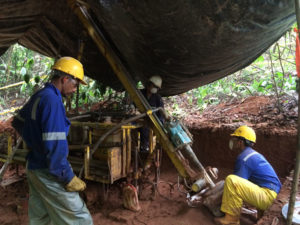Cordoba drills 150 metres of 1.15% Copper Equivalent


Continuing drilling within Cordoba Minerals Corp.‘s [CDB-TSXV; CDBMD-OTC] San Matias copper-gold project in Colombia has continued to intersect large zones of shallow, high-grade copper-gold mineralization at the Alacran copper-gold discovery within the Sam Matias Project.
The current three drill holes of the preliminary 3,000-metre diamond drilling program all returned significant intercepts of near-surface copper and gold mineralization. Drilling to date at Alacran covers over 270 metres of strike length at the northern end of a 1,300-metre defined mineralized trend.
The mineralized trend remains open in all directions and at depth. The initial 3,000-metre drilling program has been extended to test a number of geophysical targets generated during the recent Typhoon induced polarization (IP) and electromagnetic (EM) survey in conjunction with airborne magnetics and geological targets identified in the vicinity of the defined Alacran mineralization.
Alacran drilling highlights:
- ACD-009: 150 metres at 0.73% copper and 0.49 g/t gold (1.15% copper equivalent (CuEq));
- ACD-007: 169 metres at 0.48% copper and 0.33 g/t gold (0.77% CuEq).
Mario Stifano, President and CEO, said, “The current 3,000-metre drilling program has clearly demonstrated the potential for Alacran to host a large skarn copper-gold deposit within what we believe is potentially a large and prolific copper gold district. I am very pleased and excited that Cordoba and our partner High Power Exploration will immediately expand the drilling program at Alacran by an additional 2,100 metres to test areas peripheral to the currently defined Alacran deposit where recent drilling, geophysics, surface expressions and soil sampling have indicated the potential to further enlarge the discovery.”
Cordoba and High Power Exploration (HPX) are finalizing the next phase of the exploration program at the San Matias Project. Current plans will include an expansion of the Typhoon survey, follow-on drilling at Alacran and the drilling of high-priority targets defined by Typhoon IP and detailed airborne magnetic surveys with additional details to be provided in the coming weeks.
Overview
The Northern Alacran area was the focus of the three drill holes that were targeting both extensions along strike and vertically from previous drilling. All holes successfully intersected both large zones of copper-gold mineralization associated with both shallow and high-grade zones and the mineralization remains open in all directions.
Drill hole ACD-007 was located on Section 855720mN where it tested the updip extensions of historical drill hole ASA-012 (175 m at 0.74 per cent copper and 0.26 g/t gold) as a 50-metre step-out. Drilling successfully intersected a large, continuous zone of copper-gold mineralization of 169 metres at 0.48 per cent copper and 0.33 g/t gold (0.77 per cent CuEq) with mineralization remaining open both updip and downdip on section. This mineralization was also successfully intersected in drill hole ACD-008, a 50-metre step-out hole along strike to the south. Copper-gold mineralization in ACD-008 on Section 855670mN intersected 109 metres at 0.54 per cent copper and 0.24 g/t gold (0.75% CuEq) and remains open both updip and downdip on section and along strike to the south. Drill hole ACD-009 drilled on Section 855760mN targeted the southern strike extensions of the high-grade interval located in drill hole ASA-051 (111 metres at 1.01% copper and 0.38 g/t gold) as a plus-60-metre southerly step-out. The drill hole intersected a large and continuous zone of copper-gold mineralization of 150 metres at 0.73% copper and 0.49 g/t gold (1.15% CuEq) from shallow depths that correlates with step-out holes ACD-004 and ACD-001 on section. The successful intersection indicates the large widths of mineralization remain open on section both updip and downdip and along strike to the south.
Alacran copper-gold system
The Alacran copper-gold system is located within the company’s San Matias copper-gold project in the department of Cordoba, Colombia. The Alacran system is located on a topographic high in gently rolling topography, optimal for potential open-pit mining. Access and infrastructure are good. Alacran is approximately two kilometres southwest of the company’s Montiel porphyry copper-gold discovery, where recent drilling interested 101 metres of 1.0% copper and 0.65 g/t gold, and 2 km northwest of the Costa Azul porphyry copper-gold discovery, where recent drilling interested 87 metres of 0.62% copper and 0.51 g/t gold.
The copper-gold mineralization at Alacran is associated with strata-bound replacement of a marine volcanosedimentary sequence in the core of a faulted anti-formal fold structure. The deposit comprises moderately to steeply dipping stratigraphy that is mineralized as a series of subparallel replacement-style or skarn zones and associated disseminations. The copper-gold mineralization is composed of multiple overprinting hydrothermal events with the main ore phase comprising chalcopyrite-pyrrhotite-pyrite that appears to overprint a large-scale early magnetite metasomatic event.
High-temperature potassic feldspar-biotite-amphibole-albite alteration in the host geological sequence indicates that the copper-gold mineralization is proximal to a source intrusion. At least two intrusive phases, locally occurring as sills, confirm an intrusive source for the mineralizing fluids. The overall size and complexity of the hydrothermal system indicate a significant mineralization event. Mineralization occurs within all members of the sedimentary and volcanic sequence, where it can be traced over a strike length of greater than 1,300 metres and local thickness of more than 90 metres true width from the current drilling and surface sampling.
Alacran exploration
In addition to the continuing diamond drilling program, extensive soil sampling and detailed geological mapping programs are under way to further define the extent of copper-gold mineralization at Alacran and to determine if additional mineralized zones exist. The hydrothermal alteration halo associated with the known mineralization is of kilometre-scale dimensions, indicating the potential for a substantial mineralized zone and the high probability of additional mineralized areas. A Typhoon IP and EM survey also has been completed over the northern parts of the Alacran project and data are currently being interpreted.
